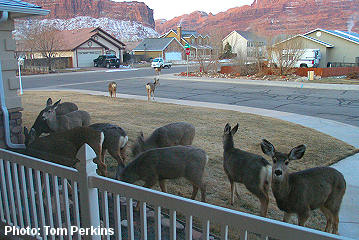Be Aware › Mule Deer

Welcome to mule deer country
Some things you should know about mule deer
Rocky Mountain mule deer, Odocoileus hemionus, are found throughout Utah and live in many types of habitats, from rugged mountain wilderness to urban neighborhoods. The animal gets its name from its large mule-like ears.
Female deer (does), typically give birth to one or two offspring (fawns) in late spring or early summer. Only male deer (bucks) have antlers, which they shed and regrow every year.


Mule deer habitat
Mule deer have the broadest distribution of any antlered game animal in North America — ranging from northern Canada to central Mexico. In Utah, mule deer migrate annually, moving from summer range in high mountain habitats to lower elevations in the winter to avoid deep snow and to find food.
Almost all foothill bench areas as well as many valley floors are traditional wintering and foraging areas for mule deer.
Mule deer can be seen throughout the year and are mainly active at dusk and dawn. In winter, they may be active throughout the day. The main prey of cougars is deer, so cougars will be found wherever deer are.
Remember: Always observe deer from a safe distance.
Mule deer are among the most watchable Utah wildlife, and can generally be seen throughout the state during all seasons of the year.
Mule deer feeding habits
Deer are ruminants — mammals that acquire nutrients from plant-based food by fermenting it in a specialized stomach before digestion.
Deer have four-part stomachs, and each stomach chamber progressively breaks down woody, leafy and grassy foods into smaller particles. These stomach chambers contain microbes that are essential to digesting food. The type of microbes in a deer’s digestive system gradually change throughout the year and are very specific to the food that is available each season.
From late spring to early fall, deer gain weight and build up fat reserves by feeding heavily on broad-leafed plants and grasses. During the winter, deer primarily feed on sagebrush and other woody plants, relying upon stored body fat to survive.
While well-intentioned people try to help deer by feeding them, they can harm them instead.
Don’t feed deer
Feeding mule deer is strongly discouraged due to public safety concerns, the spread of chronic wasting disease among deer, elk and moose, and potential harm to wildlife from introducing foods not in their diets, particularly during winter months. While it is not illegal to feed wildlife — except for in certain cities that have enacted no feeding ordinances — there are several reasons that it is highly discouraged:
- Suddenly changing a deer’s diet — especially during the winter months — can easily lead to the deer eating food that it cannot readily digest. In these situations, deer often die from starvation with full stomachs.
- When deer congregate to feed, it’s every deer for itself. The larger deer often push smaller deer and fawns aside, so they end up receiving less food than they would have received if people had left them alone.
- Attracting deer to your property through feeding may attract predators, like cougars, that follow deer herds.
- Feeding deer near neighborhoods and roadways increases the risk of vehicle collisions and other human/wildlife conflicts.
- Annual migration patterns to wintering areas may be disrupted if the deer are enticed to remain at a feeding area.
- Chronic wasting disease is a relatively rare, but fatal transmissible disease that affects the nervous systems of deer, elk and moose. Feeding deer can cause large groups of them to crowd together in one area, increasing the chance of the disease spreading from one animal to the next.
Preventing damage on your property

Most foothill areas, bench areas and valley floors are traditional wintering and foraging areas for deer. In order to find alternate food sources, mule deer may end up in people’s yards or gardens, especially during periods of drought in the summer and to avoid heavy snow in winter. If you want to try to save your plants and minimize any property damage from these wildlife visits, here are a few tips:
- Building a fence around your garden or yard that is as least 7.6 feet high is the most effective method, and is probably the only reliable way to keep deer out of your garden.
- Another fairly effective technique is to install a motion-activated sprinkler.
- Minimize browsing damage from deer by planting vegetation that they tend to avoid, or selecting native plants and shrubs that generally recover even if eaten by deer. A bonus for the latter types of plants — most are highly attractive to birds, pollinating insects and other native wildlife species!
- Securing your yard at night reduces the likelihood of deer damage. During the day, deer usually stay in the thickest vegetative cover available and as far as possible from homes and people. At night, deer leave the security of the trees and vegetation and venture out in search of food.
- Deer can become trapped and injured by falling into window wells. Once in a well, deer may crash through the glass and do damage to themselves and your home in their efforts to escape. To prevent this, cover window wells with commercially available grates, bubbles, fencing or build a cover using quarter-inch hardware cloth or wire.
Road safety
- Slow down while driving through deer habitats, especially at dawn and dusk and during the spring and winter months when they are migrating.
- Pay attention to wildlife crossing warning signs.
- Watch for movement along the roadway. If you see one deer, there will likely be more.
Keep deer safe by keeping your distance
While deer are not predators, they are still wild animals. It is especially dangerous when mule deer and other wild animals become habituated to urban environments or lose their fear of people. Some things to keep in mind:
- Especially during the late fall breeding season — called the rut — bucks can become very aggressive. They are often combative with each other, and can become very agitated with humans and pets who come near them or other members of their herd.
- It is against the law to allow your dogs to chase or harass deer.
- If you see a fawn on its own, the best thing to do is to keep your distance and leave the animal right where you found it. The mother is usually close by.
- Remember: Always observe wildlife from a safe distance.
If you have an encounter with aggressive wildlife or see animals that look sick or are injured, please report it to the nearest Utah Division of Wildlife Resources office. If the encounter or sighting occurs after hours or on the weekend, please call your local police department or county sheriff’s office, who can contact a conservation officer to handle the situation.

